Services on Demand
Journal
Article
Indicators
-
 Cited by SciELO
Cited by SciELO -
 Access statistics
Access statistics
Related links
-
 Cited by Google
Cited by Google -
 Similars in
SciELO
Similars in
SciELO -
 Similars in Google
Similars in Google
Share
Revista Facultad Nacional de Agronomía Medellín
Print version ISSN 0304-2847
Rev. Fac. Nac. Agron. Medellín vol.66 no.1 Medellín Jan./June 2013
In situ Morphological Characterization of Hylocereus spp. (Fam.: Cactaceae) Genotypes from Antioquia and Córdoba (Colombia)
Caracterización Morfológica in situ de Genotipos de Hylocereus spp. (Fam.: Cactaceae) de Antioquia y Córdoba (Colombia)
Henry Andrés Mejía1; Sandra Bibiana Muriel Ruiz2; Carlos Andrés Montoya3 and Carlos Reyes Sequeda4
1 Farming Engineer. Politécnico Colombiano Jaime Isaza Cadavid - Facultad de Ciencias Agrarias. Carrera 48 No. 7-151. Medellín, Colombia.
2 Associate Professor. Politécnico Colombiano Jaime Isaza Cadavid - Facultad de Ciencias Agrarias. Carrera 48 No. 7-151. Medellín, Colombia. <sbmuriel@elpoli.edu.co>
3 Farming Engineer. Politécnico Colombiano Jaime Isaza Cadavid - Facultad de Ciencias Agrarias. Carrera 48 No. 7-151. Medellín, Colombia.
4 Emeritus Professor. Universidad Nacional de Colombia -Sede Medellín - Facultad de Ciencias Agrarias. A.A. 1779, Medellín, Colombia. <crsequeda@unal.edu.co>
Received: August 15, 2012; accepted: April 22, 2013.
Abstract
The genus Hylocereus includes many important species for human and animal nutrition, including those known as dragon fruits. Although Colombia produces yellow pitaya on a commercial scale, there have been no advances for the red pitahaya crop. This study aimed to do an in situ evaluation of genetic material of wild red pitahaya (Hylocereus spp.) from three populations located in Antioquia and Córdoba; with special interest for the fruits, taking into account the desired characteristics by the market. To achieve this, 23 descriptors of stems and fruits, measurable in the field, were chosen; and 35 individuals where located, using GPS, and described. The populations were compared using mean comparison and the similarity was evaluated with cluster analysis. The stem descriptors differed in spine number, contour and margin hardness, areole distance and stem color; the first three are important for species distinction. According to the fruit descriptors, populations 1 and 2 presented similar fruits that were different from those of population 3, for almost all variables except total soluble solids content. The fruits of population 1 and 2 only differed for pulp weight. Individual 3 of population 1 presented fruits with the best characteristics for the market.
Key words: Dragon fruit, phytogenetic resource, wild plants, promising resources.
Resumen
El género Hylocereus presenta varias especies importantes en la alimentación humana y animal, incluyendo aquellas conocidas como pitayas rojas. Aunque Colombia produce comercialmente pitaya amarilla, no ha avanzado en el cultivo de pitaya roja. Este trabajo se propuso caracterizar in situ materiales genéticos silvestres de pitaya roja (Hylocereus spp.) provenientes de tres poblaciones de Antioquia y Córdoba, especialmente de sus frutos, según las características deseables para el mercado. Para ello, se eligieron 23 descriptores de tallos y frutos, medibles en campo; se ubicaron y georeferenciaron 35 individuos y se describieron. Las poblaciones fueron comparadas en cada uno de los descriptores usando una comparación de medias, además se evaluó la similitud entre poblaciones con un análisis de agrupamiento. Según los descriptores de tallos, hubo diferencias en: número de espinas, contorno y dureza de las márgenes, distancia entre areolas, altura y espesor de la arista, longitud y color del cladodio; las tres primeras características son importantes para diferenciar especies. Según los descriptores de fruto, las poblaciones 1 y 2 presentaron frutos más similares entre sí y diferentes de los de la población 3, en casi todas las variables excepto en el contenido de sólidos solubles totales. Los frutos de la población 1 y 2 sólo difirieron en el peso de la pulpa. El individuo 3 de la población 1 presentó frutos con mejores características para el mercado.
Palabras clave: Pitaya roja, recursos fitogenéticos, plantas silvestres, recursos promisorios.
Within the Cactaceae family, the Hylocereus genus has some edible species, commonly known as dragon fruits, pitahayas or pitayas, with actual and potential value for human and animal nutrition (Mizrahi et al., 1997; Castillo et al., 2003; Castillo, 2006; Valiente et al., 2007).
The Hylocereus species are epiphytes or hemiepiphytes; their stems are succulent, have three ribs and produce aerial roots; the leaves, transformed into spines, are grouped into areolas (specialized axillary meristems of the Cactaceae, according to Simpson, (2006); the flowers are the largest in the family, are often white and fragrant, have numerous stamens with nocturnal anthesis and are short-lived (Llamas, 2003; Grimaldo et al., 2007; Calix de Dios and Castillo, 2008; Cisneros et al., 2011).
The Hylocereus genus includes 19 species according to Bauer (2003), who reviewed some species and grouped them as one, including the yellow pitaya H. megalanthus (K. Schum. Ex Vaupel) Moran. The characteristics that are used for species identification are the number of spines per areola, the shape of the spines, the contour of the stem margin, the relative hardness of the stem margin and the size and color of the fruit exocarp (Llamas, 2003; Calix de Dios, 2005). In the pitahaya, the pulp color may vary from red to white or yellow, even within the same species, so this characteristic is not considered a substantial criterion to differentiate species (Bauer, 2003). Many Hylocereus species are diploid, but H. megalanthus is an allotetraploid, possibly derived from natural hybridization between two diploid taxa (Tel-zur et al., 2004).
The two species of pitahaya most traded in the world are the yellow pitaya H. megalanthus and the pitahaya H. undatus (Haw.) Britton and Rose (Nerd et al., 2002). The latter is highly appreciated for its fruits, ornamental value, medicinal value and its potential as a pigment (Castillo, 2006; Valiente et al., 2007) and, unlike the first one, does not have spines (Betancourt et al., 2010). Other species of the genus also produce edible red fruits and are cultivated in Central America, such as H. polyrhizus (sin. H. monacanthus, H. costaricensis, according to Bauer, 2003) and H. purpusii (sin. H. ocamponis, according to Bauer, 2003) (Grimaldo et al., 2007); and in Brazil, Bolivia, northern Argentina and Paraguay, i.e. H. setaceus (Pereira et al., 2002), although it is not cultivated commercially.
Commercial plantations of H. undatus were established in Central America with plants from home gardens and, to a lesser extent, wild plants, which has resulted in fruits that have a high heterogeneity in characteristics such as color, size and shape, among others (Castillo et al., 2005). In Colombia, there are both yellow pitaya and red pitahaya. Although the first is grown even in small areas, it is very valuable, since the country is recognized internationally as a pioneer in its cultivation, technological development and as one of its largest producers (Pereira et al., 2002; Betancourt et al., 2010; Delgado et al., 2010, García and Quiros, 2010). The red pitahaya, however, mainly grows wild in the settled areas of Antioquia (tropical dry forest zone), the Atlantic coast, Tolima, Santander and Valle del Cauca.
The separation of species and varieties in the genus Hylocereus is difficult due to the high intra- and interspecific hybridization (Tel-zur et al., 2004), which has caused some taxonomic confusion. Therefore, there have been several studies on morphological characterization of the genotypes. For the first, done in Nicaragua, 50 qualitative and quantitative characteristics capable of measuring the phenotypic variability of H. undatus were evaluated (González and Alvarado, 2004). The authors proposed a detailed guide of morphological descriptors and recognized 14 characteristics that could be used to differentiate pitahaya materials (González and Alvarado, 2004).
Another study evaluated the diversity of H. undatus through morphological characterization and sexual compatibility of 6 genotypes (Castillo et al., 2005), the authors concluded that the reproductive characteristics were the most important to separate the genotypes. A third study conducted a morphometric analysis of 21 genotypes of H. undatus using 47 characteristics in a multivariate analysis (Grimaldo et al., 2007) but, unlike the previous studies, the authors found that the most important variables to separate genotypes were those of the stems (Grimaldo et al., 2007). Finally, in a study conducted in Israel, a morphological and genetic characterization of 64 accessions of Hylocereus, Selenicereus and Epiphyllum was carried out, including variables such as: nuclear DNA content, stomatal density and length and plant production parameters, and found that there is high genetic variability among accessions and therefore, excellent prospects for domestication and conservation of these genetic resources (Tel-zur et al., 2011).
In Colombia, little is known about the species of red pitahaya and it is not known if there is natural hybridization between them, as recorded in Mexico and Central America (Tel-zur et al., 2004). It is necessary to carry out Hylocereus characterization because this resource could be a potential crop in dry tropical habitats or in those with irregular rainfall. So far, only one study has evaluated methods of propagation for the two species (Suarez, 2011). Therefore, the aim of this study was to describe different genetic materials of the red pitahaya (Hylocereus spp.) from three wild populations of Antioquia and Córdoba, and to carry out an in situ assessment of them and especially of the fruits in terms of the most desirable characteristics for the market.
Materials and methods
The plant material was obtained from three wild populations: the first population is found among the municipalities of San Jerónimo, Sopetrán and Santa Fe de Antioquia (Antioquia Department) (between 06°34'20,1''N, 75°48'00,8''W and 06°28'43,9''N, 75°44'49,7'' W), whose average annual temperature is 27.4 °C and average rainfall is 1,097 mm (average data for the years 1990-2010, 26225030 station Cotové, IDEAM). The second population is comprised of plants established on the eastern sector of the Cauca river in the municipalities of Salgar, Bolombolo, Titiribí and Concordia (Antioquia Department) (between 06°32'09,7''N, 75°49'57,2''W and 06°30'22,1''N, 75°46'05,8''W), whose average temperature is 26 °C and precipitation is less than 1,500 mm (Department of Antioquia, 2012). The third population is located in the municipality of Monteria (Córdoba Department) (08°72'08,1''N 75°59'55,98''W), whose average temperature is 27.9 °C and annual average rainfall is 1,285 mm (The National Weather Service, 2012). All locations correspond to a tropical dry forest zone (Figure 1).
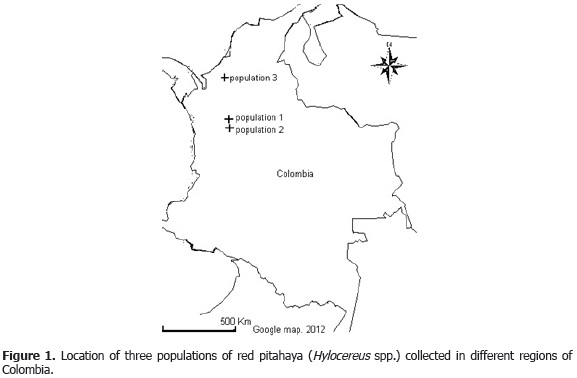
For the definition of the descriptors, the work of González and Alvarado (2004) was taken as the reference, from which 23 descriptors of stems and fruits that are measurable in the field were selected; the variables of pulp color, fruit bract number, direction of the curvature of the lobe and stem color were later added because of the variation found. The information was recorded onto a previously prepared sheet, as recommended by Ríos (2006).
The description was performed in situ, in regions where individuals were found, between March and June 2011. At each site, observation tours were carried out along with consultations with the local people about the location of wild specimens. Individuals were randomly selected at each site and were georeferenced using global positioning equipment (GPS Garmin®) and described. Additionally, the passport data of the evaluated individual was produced.
For the identity of the species, an expert was consulted (Dr. Salvador Arias from the Botanical Garden of Instituto de Biología, Universidad Nacional Autónoma de México), who identified the first two populations as belonging to the species H. undatus and the third population as belonging to another species, H. monacanthus (Lem.) Britton and Rose; however, it is necessary to study the flowers for confirmation.
Four stems were taken from each described individual, which were labeled with a sequence number (accession number) that described where the accession was collected. Each stem was measured lengthwise and then fractionated by cutting 25 cm from each one, as described by Costa et al. (2006), for a high power of rooting. The collected stems were transported to El Politécnico Colombiano Jaime Isaza Cadavid (Sede Niquía) where they were disinfected with a solution of sodium hypochlorite 6% and seeded in one-kg nursery bags with a previous application of rooting hormone (alpha-naphthaleneacetic acid). The substrate for the bags consisted of disinfected, coarse sand. From population 1, ten fruits were obtained, which were suitable for evaluation at the time of gathering, from ten individuals. From population 2, seven fruits were obtained: six acquired through a local person and the seventh from one of the described plants; and from population 3, five fruits were obtained from two different plants, which were measured in the laboratory. The seeds extracted from the fruits were washed and dried under natural environment conditions and stored in transparent plastic bags labeled and stored for further studies.
The method of measuring each descriptor is recorded in Table 1. A database of described individuals was created and the populations were compared by a mean comparison for each descriptor. A Tukey test was carried out to determine the difference in the mean values of the two groups. Additionally, there was a cluster analysis to identify the most similar accessions according to the set of characteristics evaluated by the Nearest Neighbor Method, based on the Squared Euclidian Distance, with the program MVSP 3.21. Prior to this analysis, an evaluation was carried out for the correlation between some variables that, in the opinion of the researchers, could have been measuring the same characteristics and those that presented correlation were removed. For conducting the analysis, all the variables were standardized according to the formula: xi-X / S, where xi is the value of variable, X is the average of the variable and S is the standard deviation.
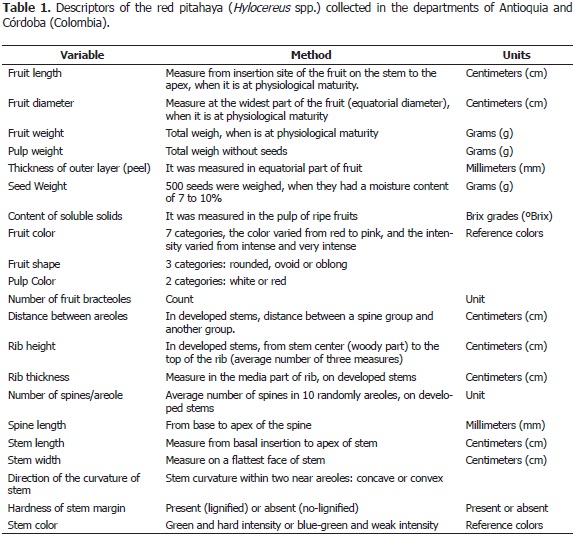
Results and discussion
A total of 35 materials were described in the field, of which 25 were from population 1, five from population 2 (both from the Department of Antioquia) and five from population 3 (Department of Córdoba). The individuals were mainly found on isolated trees in pastures and roadsides, with heights between 3 and 30 m, especially above samán (Pithecellobium saman (Jacq.) Benth.), piñon de oreja (Enterolobium cyclocarpum (Jacq.) Griseb.) and matarratón (Gliricidia sepium (Jacq.) Kunth ex Walp.).
According to the stem descriptors, there were significant differences between populations for the variables: direction of curvature of the stem, margin hardness (presence of sclerenchyma), distance between areoles, number of spines, rib height, rib thickness, length and color of the stem (Table 2); the first three were considered important for species differentiation. The largest differences occurred between populations 1 and 3; and 2 and 3, in almost all characteristics except rib height and spine length. Populations 1 and 2 differed only in rib height and stem width, which was because the individuals in population 1 had thicker and more succulent stems. Castillo et al. (2005) found that the major differences between accessions were presented in the characteristics of reproductive structures, so it will be necessary to conduct a study of this material in the flowering season.
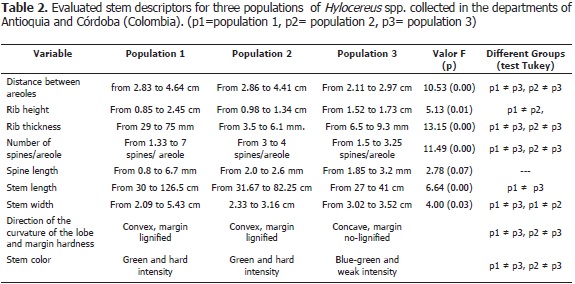
The cluster analysis of the stem descriptors (Figure 2), at a Euclidian distance of 9, separated two distinct groups: the first consisting of individuals of populations 1 and 2; and the second formed by the individuals of population 3, which differed from the other two by having a smaller number of spines, a different curvature of the lobe and a different stem color, among others. At a Euclidian distance of 6, it was observed that the first subgroup was subdivided into two, the first subgroup consisted of mixed individuals of populations 1 and 2, so it can be said that they were more similar. While the second subgroup was formed by individuals 17 and 21 from population 1 and the variable that determined this separation was the length of the spines, because these individuals had spines longer than the others.
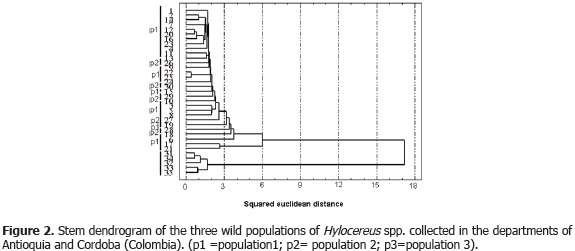
According to the fruit descriptors, there were significant differences between the populations for all the measured variables (Table 3). Population 3 differed with respect to populations 1 and 2 for all the characteristics, and formed a homogeneous group. Fruits of populations 1 and 2 differed only in the pulp, which weighed more in population 2. The cluster analysis of the fruits separated them into two groups, at a Euclidean distance of 4. The first group consisted of the fruits from populations 3, which were characterized by: having a medium length, and medium and small diameters, being very light, as well as moderately sweet to very sweet, and having few bracts and white-colored pulp. The second group consisted of fruits of population 1 and 2, which were characterized as fruits of a medium to large size that were light in weight and moderately sweet to very sweet, with abundant bracts and bright red pulp (Figure 3, Table 3).
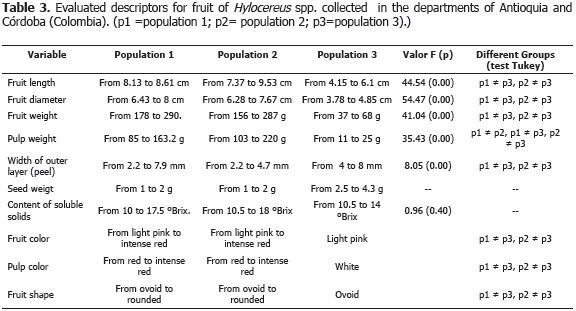
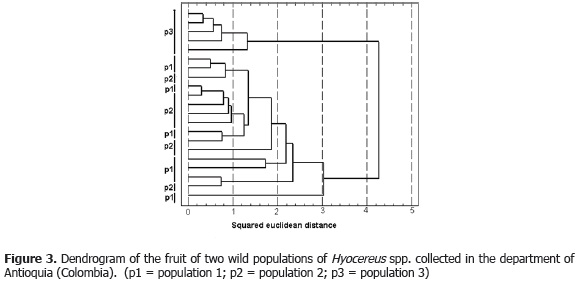
Colombia has Technical Standard NTC 1993-3554 (ICONTEC, 1996) for the commercialization of the yellow pitaya, in which 6 fruit weight categories are established, ranging from those less than or equal to 110 g to fruits of more than 631 g. Taking this standard as a reference for the red pitahaya, the collected fruits occupy 5 of 6 categories, except the largest one. Also, Nicaragua's standard defines two weight categories for the international market of the red pitahaya (Republic of Nicaragua-Ministry of Development, Industry and Trade, 2001), the first of which includes fruits between 250 and 300 g in weight, according to which, only 18% of the collected fruits would meet the requirements of appropriate size for the market.
The highest percentage of soluble solids in the fruits was 18 °Brix for one fruit of population 2, but for the characteristics of size, this accession had low values. 45% of the fruits showed the average values required by the international market, which range between 13 and 15 °Brix (Stuber and Mojica, 1997, cited by Gonzalez and Alvarado, 2004). Initial results of the water requirements and nutritional levels in the yellow pitaya showed an improvement in fruit quality and higher than average Brix (Mosquera et al., 2011). In the future, through the modification of water requirements and nutritional levels in the pitahaya, the effect of both on the characteristics of red pitahaya fruit could be evaluated.
The variable of fruit weight presented at least 156 g and a maximum of 290 g in populations 1 and 2; placing all the fruits in the light-weight category (González and Alvarado, 2004), probably this variable is influenced by natural conditions faced by wild materials. Since this is an important variable for marketing, it is necessary to evaluate their behavior when establishing a culture of collected materials, with applied fertilization and proper handling. Individual 3 from population 1 presented the best characteristics for the market, such as fruit weight, pulp weight, fruit diameter and a high content of soluble solids (17.5 °Brix), which would be of interest for its distribution. The fruit weight from population 3 ranged between 37 and 68 g, reflecting smaller sizes than those of Antioquia.
This study demonstrates that the studied natural populations of pitahaya from the two departments show high variation in the morphological characteristics that were evaluated in situ. Although the three studied sites have the same climatic conditions, to fortify the results, the same variables should be evaluated in accessions established in a single environment; thereby, confirming if the variation found might have been affected by uncontrolled environmental factors in this observational study, such as different soil types, among others. Studies in other countries have found high variation in characteristics of agronomic importance, even within the same species H. undatus (Tel-zur et al., 2011), which is considered favorable for future breeding studies.
In this study, a collection of 35 accessions was made from two departments of Colombia. A characterization of wild populations of red pitahaya from other regions will give fuller knowledge of these phytogenetic resources, which are little known in the country (Fernández, 2006), which could be an economical option for rural communities in dry regions, where climatic conditions are restrictive for other crops.
According to the field observations, it is recommended that research start with the identification of pathogens and insects associated with the plants because symptoms were registered that could be limiting factors for projected commercial cultivation.
Conclusions
The 35 materials described in situ showed variation in their morphological characteristics of stems and fruits, mainly for population 3 with respect to populations 1 and 2, which formed a homogeneous group. The material collected in the department of Córdoba showed significant differences in three important characteristics for the identification of species: number of spines by areole, edge hardness and edge contour. The inclusion of other characteristics associated with the flowers of all the populations would confirm the magnitude of the differences and establish whether they are intra- or interspecific variations.
The red pitahaya fruits were found to have a content of soluble solids favorable to the market, although their size was small. Individual 3 from population 1 presented the best characteristics for the market; therefore, this material could be promising for further multiplication and evaluation in commercial cultivation.
It is important to note that this was a in situ morphological characterization study. The differences are a guide to determine if the most promising accession characteristics are maintained when setting in a single environment where there is no interference from uncontrolled variation.
Acknowledgements
The Politécnico Colombiano Jaime Isaza Cadavid gave partial funding for this research through Project No. 2061090163, the Universidad Nacional de Colombia - Medellin allowed for the collection of material in the Land Station Cotové, the residents of different sites guided us in the field, Florian Sneider coordinated the access to material from Monteria - Córdoba, and Dr. Salvador Arias of the Botanical Garden of the Instituto de Biología, UNAM by the identification of the collected materials.
Bibliography
Costa, D., R. Pio, J.A. Scarpare, M. Neubern, LF. Paes, T.P. Dias e S.T. Bakker. 2006. Propagação da pitaya 'vermelha' por estaquia. Ciência e Agrotecnologia 30(6): 1106-1109. [ Links ]
Bauer, R. 2003. A synopsis of the tribe Hyloceraceae F. Buxb. Cactaceae Systematics Initiatives 17: 3-63. [ Links ]
Betancourt, B., J.C. Toro, H. Mosquera, J.C. Castellanos, R. Martínez, A. Aguilera, L.E. Perdomo y A. Franco. 2010. Agenda prospectiva de investigación y desarrollo tecnológico para la cadena productiva de la pitaya amarilla en fresco en el Valle del Cauca. Ministerio de Agricultura y Desarrollo Rural. Proyecto Transición de la Agricultura. Universidad del Valle, Universidad Nacional de Colombia, Servicio Nacional de Aprendizaje - Sena. Colciencias. Cali. 200 p. [ Links ]
Cálix de Dios, H. 2005. A new subspecies of Hylocereus undatus (Cactaceae) from Southeastern México. Haseltonia 11: 11-17. [ Links ]
Calix de Dios, H. y R. Castillo. 2008. Estudio sobre la pitahaya amarilla de la península de Yucatán. Trópico Rural 1(7):31-35. [ Links ]
Castillo, R., M. Livera, A. Brechú y J. Márquez. 2003. Compatibilidad sexual entre dos tipos de Hylocereus (Cataceae). Revista Biología Tropical 51(3-4): 699-706. [ Links ]
Castillo, R., M. Livera y G.J. Márquez. 2005. Caracterización morfológica y compatibilidad sexual de cinco genotipos de pitahaya (Hylocereus undatus). Agrociencia 39(2): 183-194. [ Links ]
Castillo, R. 2006. Aprovechamiento de la pitahaya: bondades y problemáticas. Caos Conciencia 1: 13-18. [ Links ]
Cisneros, A., R. Benega and N. Tel-Zur. 2011. Ovule morphology, embryogenesis and seed development in three Hylocereus species (Cactaceae). Flora 206: 1076-1084. [ Links ]
Delgado, A., T. Kondo, K. Imbachi, E. Quintero, M. Manrique y J. Medina. 2010. Biología y algunos datos morfológicos de la mosca del botón floral de la pitaya amarilla, Dasiops saltans (Townsend) (Diptera: Lonchaeidae) en el Valle del Cauca, Colombia. Boletín del Museo de Entomología de la Universidad del Valle 11: 1-10. [ Links ]
Departamento de Antioquia - Municipio de Titiribí. 2012. Plan de Desarrollo Municipal 2012-2015. En: http://titiribi-antioquia.gov.co/apc-aa-files/31306339373162396333343434343736/acuerdo-pdmaprobado-31-de-mayo.pdf. 170 p.; consulta: abril 2012. [ Links ]
Fernández, J.L. 2006. Advances y perspectivas en el estudio de las Cereeae e Hylocereeae colombianas. p. 37, En: Libro de Resúmenes IX Congreso Latinoamericano de Botánica, Santo Domingo, República Dominicana. [ Links ]
García, M. y O. Quirós. 2010. Análisis delcomportamiento de mercado de la pitahaya (Hylocereus undatus) en Costa Rica. Tecnología en Marcha 23(2): 14-24. [ Links ]
González, S. y J. Alvarado. 2004. Utilización de caracteres cualitativos y cuantitativos determinantes en la variación fenotípica de pitahaya (Hylocereus undatus Britt and Rosse), que permiten proponer una guía de descriptores. Tesis de Ingeniería Agronómica. Facultad de Agronomía. Universidad Nacional Agraria, Nicaragua. 95 p. [ Links ]
Grimaldo, J.O., T. Terrazas, V.A. García and M. Cruz. 2007. Morphometric analysis of 21 pitahaya (Hylocereus undatus) genotypes. Journal of the Professional Association for Cactus Development 9: 99-117. [ Links ]
Instituto de Hidrología Meteorología y Estudios Ambientales (IDEAM). 2011. Datos promedio de años 1990-2010, estación 26225030 Cotové. IDEAM, Ministerio del Medio Ambiente, Bogotá [ Links ].
Instituto Colombiano de Normas Técnicas y Certificación. (ICONTEC). 1996. NTC 3554: frutas frescas. Pitahaya amarilla. Icontec, Bogotá. 12 p. [ Links ]
Llamas, K. 2003. Cactaceae pp. 163-165. In: Llamas, K. (ed.). Tropical flowering plants: A guide to identification and cultivation. Timber Press Inc., Portland, Oregon, USA. 424 p. [ Links ]
Mizrahi, Y., A. Nerd and P.S. Nobel. 1997. Cacti as crops. Horticultural Review 18: 291-320. [ Links ]
Mosquera, H., B. Betancourt, J. Castellanos y L.E. Perdomo. 2011. Vigilancia comercial de la cadena productiva de la pitaya amarilla. Cuadernos de Administración 27(45): 75-93. [ Links ]
Nerd, A., Y. Sitrit, R. Avtar and Y. Mizrahi. 2002. High summer temperaturas inhibit flowering in vine pitaya crops (Hylocereus spp.). Scientia Horticulturae 96: 343-350. [ Links ]
Pereira, K., N. Vilela, J. Ramos e A. Pereira. 2002. Informações preliminares sobre uma espécie de pitaya do Cerrado. Documento 62. Embrapa, Brasil. 18 p. [ Links ]
República de Nicaragua - Ministerio de Fomento Industria y Comercio. 2001. Norma de procedimiento para la producción, comercialización y exportación de la fruta fresca y pulpa de pitahaya. En: http://cedoc.magfor.gob.ni/documentos/cedoc/E70-0314.pdf. 16 p.; consulta: abril 2012. [ Links ]
Ríos Ll. 2006. Descriptores para la caracterización del cultivo de yuca (Manihot esculenta Crantz). pp. 106-129. En: Estrada, R., T. Medina y A. Roldán (ed.). Manual para caracterización in situ de cultivos nativos conceptos y procedimientos. INIEA, Lima, Perú. 167 p. [ Links ]
Simpson, M. 2006. Cactaceae. p.p. 244-246. In: Plant systematics. Elsevier Academic Press, San Diego, California. 590 p. [ Links ]
Suárez, R. 2011. Evaluación de métodos de propagación en pitahaya amarilla Selenicereus megalanthus (Haw.) Britt and Rose y pitahaya roja Hylocereus polyrhizus (Haw.) Britt and Rose. Tesis de Maestría en Ciencias Agrarias. Facultad de Ciencias Agropecuarias, Universidad Nacional de Colombia. Palmira. 280 p. [ Links ]
Tel-zur, N., S. Abbo, D. Bar-Zvi and Y. Mizrahi. 2004. Genetic Relationships among Hylocereus and Selenicereus vine Cacti (Cactaceae): Evidence from hybridization and cytological studies. Annals of Botany 94: 527-534. [ Links ]
Tel-Zur, N., Y. Mizrahi, A. Cisneros, J. Mouyal, B. Schneider and J.J. Doyle. 2011. Phenotypic and genomic characterización of vine cactus collection (Cactaceae). Genetic Resources and Crop Evolution 58: 1075-1085. [ Links ]
The National Weather Service. Montería, Colombia. En: http://www.weatherbase.com/weather/weather.php3?s=592500&cityname=Monteria-Colombia; consulta: abril 2012. [ Links ]
Valiente, A., R. Santos, M. Arizmendi and A. Casas. 2007. Pollination biology of the hemiepiphytic cactus Hylocereus undatus in the Tehuacán Valley, Mexico. Journal of Arid Environments 68(1): 1-8. [ Links ]













